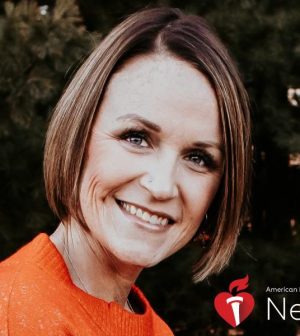- Navigating Your Midlife Crisis: Embracing New Possibilities
- City Raccoons Showing Signs of Domestication
- Mapping the Exposome: Science Broadens Focus to Environmental Disease Triggers
- One Week Less on Social Media Linked to Better Mental Health
- Your Brain Changes in Stages as You Age, Study Finds
- Some Suicide Victims Show No Typical Warning Signs, Study Finds
- ByHeart Formula Faces Lawsuits After Babies Sickened With Botulism
- Switch to Vegan Diet Could Cut Your Greenhouse Gas Emissions in Half
- Regular Bedtime Does Wonders for Blood Pressure
- Dining Alone Could Mean Worse Nutrition for Seniors
AHA News: Her Daughter’s Earache Might Just Have Saved Her Life

THURSDAY, March 18, 2021 (American Heart Association News) — When her 3-year-old daughter’s earache stretched into a sixth hour, Sarah Conaway decided it was time to get some answers. Even if it was 3 a.m.
Conaway woke her mom, who lived with them, and they drove to the nearby children’s hospital in Omaha, Nebraska. Sitting in the lobby, Conaway was filling out paperwork when she said, “I can’t feel my right side.”
“She’s just had a stroke,” thought Julie Williams, Conaway’s mom.
Williams ran for help. A medical team jumped into action, getting her next door to another hospital.
An MRI was inconclusive. Hours later, a second MRI showed Conaway had experienced an ischemic stroke, the kind caused by a blood clot. The news was jarring because she was taking blood thinners.
Over the next two days, Conaway began to slowly recover her faculties, wiggling a toe and swallowing. She also had a terrible headache.
By the third day, Conaway’s headache intensified significantly.
“Thankfully, my mom went all Mama Bear and asked them to do another MRI,” Conaway said.
It showed she was having another stroke – this time hemorrhagic, meaning caused by a burst blood vessel in her brain.
Her blood thinners exacerbated the bleeding. The drugs had to be reversed, even if it meant raising the possibility of more blood clots.
Luckily, no additional clots occurred. And after two weeks in the ICU, Conaway moved to in-patient rehab. She spent the next five weeks relearning how to walk and manage simple daily tasks.
“Sarah’s a very strong and determined individual,” Williams said. “She fought with every ounce of energy she had.”
She’d done it before, too.
At 21, she had a blood clot called a deep vein thrombosis and was diagnosed with systemic lupus, an autoimmune condition that causes inflammation and pain throughout the body. A few years later, she had a blood clot in her liver and suffered multiple organ failure, leading to the diagnosis of a clotting disorder. That’s why she was taking blood thinners.
“They told me at 24 that I wouldn’t have any more clots, but I still had two strokes,” she said.
Now, five years later, Conaway’s strong resolve continues to shine.
Because of where the strokes affected her brain, Conaway lost 50%of her vision in each eye. Using her right side remains a struggle. She often feels a pins and needles sensation on that side. Still, she can walk and has found some ways to use her hand.
Aphasia and short-term memory loss prevented her from returning to her career as a marketing executive. However, her aphasia has progressed to the point where “most people wouldn’t notice unless they really paid attention.” She’s even learned to drive again.
Before the stroke, Conaway regularly gave presentations. Two years after her stroke, she managed to do it again, starting with a Christian women’s ministry. She continues to volunteer with her church and several nonprofit organizations, including the American Heart Association.
Looking back, Conaway said it was lucky her daughter’s earache – which was ultimately diagnosed as an ear infection – brought them to the hospital that night.
“I wouldn’t be here today if we weren’t there when it happened,” she said. “It was divine intervention.”
Now 39, Conaway continues to take blood thinners. While that puts her at risk of another hemorrhagic stroke, she tries not to dwell on it.
“I can’t live my life in fear of that,” she said. “I’m just thankful to live to 40 and hope to have another 40 years.”
American Heart Association News covers heart and brain health. Not all views expressed in this story reflect the official position of the American Heart Association. Copyright is owned or held by the American Heart Association, Inc., and all rights are reserved. If you have questions or comments about this story, please email editor@heart.org.
By Suzanne Marta
Copyright © 2025 HealthDay. All rights reserved.










